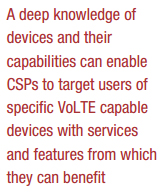VoLTE has already proven to be a success, at least in terms of market penetration, writes Robert Eriksson. An ever-growing number of communications service provider (CSPs) have deployed VoLTE as a voice service overlay for their LTE networks, offering enhanced service quality.
The benefits of launching VoLTE are also becoming clearer. At the recent IMS World Forum in Amsterdam, for example, several CSPs reported that VoLTE is having a positive impact on subscribers, with some suggesting that it has already helped to reduce churn, while others talked about the enhanced service quality and experience it offers.

However, there are several challenges ahead. First, there is a growing number of VoLTE-capable devices, each of which may be configured differently. The GSA reports that there are now more than 400 VoLTE compatible smartphones, with more arriving each month. Since users gain their experience of VoLTE through their devices, device performance is fundamental to its success. Growing numbers of devices means that the issue of device interoperability and performance cannot be underestimated. Moreover, as an open market in VoLTEcapable devices develops, CSPs will have to ensure that new devices can work seamlessly on their networks, which means they must wrestle with the problem of both approved and also new, unapproved devices.
The importance of device interoperability
The second issue is that VoLTE networks cannot exist as islands. As more CSPs in the same country deploy VoLTE networks, they will need to ensure that their subscribers can enjoy the benefits of VoLTE when they call subscribers on other networks. Although a high volume of calls will be made to subscribers within the same network – on-net, many more will likely be made to subscribers of other CSPs – off-net. As such, achieving interoperability with other CSPs is a mandatory next step.
All of this matters, because CSPs in different countries are promoting strong marketing messages to support their VoLTE rollouts. Many have positioned the service, not as a premium offer, but as a superior one – that is, one that offers better coverage, better indoor penetration and, crucially, better quality not only in terms of audio but also in terms of call establishment time. As such, they are promising a better customer experience as an incentive to migrate to the latest VoLTE compatible devices. Having gone to great lengths to implement VoLTE in the first step, they need to justify the hype they are building.
In this context, it has become more important than ever to ensure that CSPs can deliver the promised performance benefits. Put simply, if they do not deliver the right level of customer experience, it’s likely that disappointed customers will, instead of using VoLTE as a native experience, simply default to alternative applications.
And that’s where things become tricky. Devices are the medium through which users will experience VoLTE but the highly fragmented device market means that keeping control of the experience will become increasingly difficult, especially as inter-network interoperability becomes a reality. As a result, CSPs need to build a device strategy that enables them to both manage device performance within their network and also with network partners. Worse, even though they may seek to maintain approved device lists, this will become increasingly difficult. A user that prefers to use his own device will expect that it works. As such, managing subscriber expectations while delivering the best experience will be a critical task for CSPs.
 This means that CSPs must address this problem today. They will have to support parallel approaches. First, to deal with interoperability issues within their networks. Second, to manage device interoperability between their networks and those of their peers. This will be a continuous, ongoing task and one that will need a ready supply of accurate, real-time and historic network data.
This means that CSPs must address this problem today. They will have to support parallel approaches. First, to deal with interoperability issues within their networks. Second, to manage device interoperability between their networks and those of their peers. This will be a continuous, ongoing task and one that will need a ready supply of accurate, real-time and historic network data.
This data will be required to enable both troubleshooting for customer issues, such as: “My new shiny device drops calls, please fix it”, and also for ensuring that interoperability performance is maintained as new devices are launched. It’s going to be tough, but it’s now possible, thanks to systems such as Polystar’s Device Insights which collects network data and presents it in an intelligent manner.
The first step is to understand which devices are in use and for which services. If user data can be correlated with this, then an accurate picture of who is using which device, when, where and for what purpose can be obtained. In turn, this will allow CSPs to tune VoLTE services according to the capabilities of different devices – as well as enabling better customer service to be offered. If customer service agents can understand not only what a user is trying to do but also the context, they can help them faster.
Similarly, device manufacturers regularly release updates, which may impact VoLTE performance. Managing software releases, identifying and tracking known and emerging issues creates a significant overhead, unless analytics information is used to track devices, their software revision and the associated problems. Such insight will allow CSPs to be proactive with new releases, informing customers of known issues and providing tips suggesting how to avoid them.
Of course, problem resolution and avoidance is only part of the customer experience. A deep knowledge of devices and their capabilities can enable CSPs to target users of specific VoLTE capable devices with services and features from which they can benefit. As new capabilities related to VoLTE investments – for example, video over LTE (ViLTE) or voice over Wi-Fi (VoWiFi) – are launched, CSPs should target them to the existing population of VoLTE users with the right versions of supported devices.
VoLTE can only continue its success if CSPs pay close attention to the devices in their networks. They must know what devices are present, the software versions they support, who is using them and how. Interoperability between devices and between networks is critically linked to this knowledge. If the superior capabilities of VoLTE are to translate into a better customer experience, CSPs need to deploy powerful analytics solutions that are capable of collecting, processing and presenting this information when and where it is needed.






